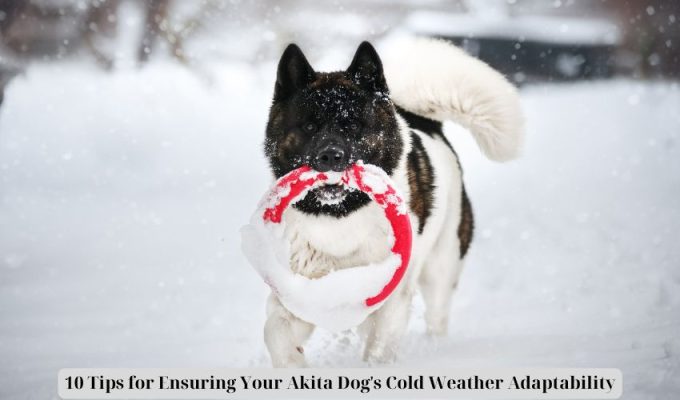Discover 10 essential tips to help your Akita Dog thrive in cold weather, ensuring their adaptability and comfort throughout the winter months.
Introduction to Akita dogs and their natural cold weather adaptability
The Akita, also known as the Japanese Akita, the Akita Inu, or the Japanese Akita Inu, is a large dog breed from Japan. Akitas are known for their loyalty, courage, and independence. They have a thick, double coat that is weather-resistant, making them well-suited for cold weather climates. Originally bred for hunting large game such as bears and boars, Akitas have adapted to thrive in colder temperatures. Their natural cold weather adaptability is a result of their physical attributes, including a dense double coat and built-in layer of insulation from higher body fat percentage.
Physical Attributes of Akitas for Cold Weather Adaptability
– Dense double coat provides excellent insulation against the cold
– Higher body fat percentage acts as a built-in layer of insulation to retain body heat
– Furry feet provide traction on slippery surfaces
– Water-resistant coat protects against moisture and wind chill
Safety Tips for Cold-Weather Breeds
– Research temperature guidelines to ensure the safety and well-being of your Akita in cold weather
– Provide shelter and warmth for your Akita when temperatures drop
– Monitor your Akita for signs of discomfort or distress in cold weather
– Consider using protective gear such as dog boots to protect your Akita’s paws from ice and snow
– Ensure your Akita has access to fresh water and a warm, dry place to rest in cold weather
Providing proper shelter for your Akita during winter months
When it comes to providing shelter for your Akita during the winter months, it’s important to ensure that they have a warm and comfortable space to retreat to. A sturdy, insulated dog house can provide protection from the elements, such as wind, rain, and snow. Make sure the dog house is raised off the ground to prevent moisture from seeping in, and add a thick layer of bedding, such as straw or blankets, for extra warmth.
Tips for providing proper shelter:
- Choose a dog house that is large enough for your Akita to comfortably stand up, turn around, and lie down in.
- Ensure that the dog house is well-insulated and has a door or flap to keep out drafts.
- Place the dog house in a sheltered area, away from strong winds and direct exposure to the elements.
- Check the dog house regularly for any signs of wear and tear, and make any necessary repairs to maintain its integrity.
By providing a warm and secure shelter for your Akita during the winter months, you can help ensure that they stay comfortable and protected from the cold weather.

Maintaining a healthy diet to support your Akita’s cold weather resilience
A well-balanced diet is essential to support your Akita’s cold weather resilience. Providing high-quality protein, such as lean meats or fish, can help maintain their muscle mass and energy levels. Additionally, incorporating healthy fats, like omega-3 fatty acids from sources such as salmon or flaxseed, can contribute to a shiny coat and provide insulation against the cold. It’s important to consult with a veterinarian to determine the appropriate portion sizes and nutritional requirements for your Akita based on their age, activity level, and overall health.
Key nutrients for cold weather resilience:
– Protein: Supports muscle maintenance and energy levels
– Healthy fats: Provides insulation and promotes a shiny coat
– Omega-3 fatty acids: Contributes to overall health and well-being
– Antioxidants: Helps boost the immune system and protect against environmental stressors
– Vitamin D: Supports bone health and overall immunity
Feeding tips for cold weather resilience:
– Offer smaller, more frequent meals to maintain energy levels
– Ensure access to fresh, clean water at all times, as hydration is crucial in cold weather
– Consider incorporating warming foods such as cooked vegetables or whole grains to provide additional warmth
– Monitor your Akita’s weight and adjust their diet as needed to prevent obesity or malnutrition
By prioritizing a nutritious diet tailored to your Akita’s specific needs, you can help support their resilience in cold weather and ensure their overall well-being.
Exercise and outdoor activities to keep your Akita active and warm
Regular exercise is essential to keep your Akita healthy, active, and warm, especially during colder months. Consider engaging in activities that provide mental and physical stimulation for your Akita. Here are some exercise and outdoor activity ideas for your Akita:
1. Long walks
Take your Akita for long walks to keep them active and provide mental stimulation. Consider varying your walking routes to keep things interesting for your dog.
2. Hiking
Akitas are known for their endurance and strength, making them great hiking companions. Take your Akita on hiking trips to explore new trails and keep them physically fit.
3. Interactive playtime
Engage in interactive playtime with your Akita by playing games like fetch, tug-of-war, or hide and seek. These activities provide mental stimulation and help keep your dog warm through movement.
4. Obedience training
Incorporate obedience training into your Akita’s exercise routine. Training sessions not only provide mental stimulation but also help strengthen the bond between you and your dog.
5. Dog sports
Consider enrolling your Akita in dog sports such as agility, obedience trials, or tracking. These activities not only keep your dog physically active but also provide opportunities for socialization and mental engagement.
Remember to consider the weather conditions when engaging in outdoor activities with your Akita. In colder temperatures, ensure your dog stays warm and protected from the elements. Always monitor your Akita for signs of discomfort or fatigue during outdoor activities.
Grooming and coat maintenance for cold weather protection
Regular grooming and coat maintenance are essential for cold-weather breeds to ensure they are adequately protected from the elements. Brushing your dog’s coat regularly helps to remove loose fur, dirt, and debris that can accumulate and mat in the fur. This is particularly important for breeds with thick, double coats, as mats and tangles can trap moisture close to the skin, leading to skin irritation and potential cold-related issues.
Grooming tips for cold-weather breeds:
- Brush your dog’s coat at least once a week to remove loose fur and prevent matting.
- Use a slicker brush or undercoat rake to reach the dense undercoat and remove dead hair.
- Bathe your dog as needed, using a gentle dog shampoo to keep the coat clean and free of debris.
- Trim the fur between your dog’s paw pads to prevent ice and snow buildup.
Coat maintenance for cold-weather protection:
- Ensure your dog’s coat is dry before going outside in cold or wet weather to prevent moisture from getting trapped in the fur.
- Consider using a dog-safe conditioner to keep the coat soft and manageable, especially in dry winter conditions.
- Check your dog’s coat for signs of irritation or dryness, and consult with a veterinarian if you notice any skin issues.
- Provide your dog with a warm, dry shelter and bedding to retreat to when the weather is particularly harsh.
Monitoring your Akita’s health during the winter season
The winter season can present unique health challenges for your Akita, so it’s important to monitor their well-being closely. Here are some tips to help you keep your Akita healthy during the colder months:
Regular vet check-ups
Schedule regular check-ups with your veterinarian to ensure your Akita is in good health. This is especially important during the winter when certain health issues, such as joint pain and arthritis, may be exacerbated by the cold weather.
Protect their paws
Cold temperatures and icy conditions can be tough on your Akita’s paws. Consider using paw balm or booties to protect their feet from ice, snow, and salt on the roads and sidewalks.
Watch for signs of hypothermia
Keep an eye out for signs of hypothermia in your Akita, such as shivering, lethargy, and weakness. If you notice any of these symptoms, bring them inside and warm them up immediately.
Provide a warm, cozy shelter
If your Akita spends time outdoors, make sure they have a warm, dry shelter to retreat to. Provide plenty of blankets and bedding to keep them comfortable in the cold.
Adjust their diet
Some dogs may need more calories in the winter to maintain their body temperature, while others may need to reduce their food intake if they are less active. Consult with your vet to determine the best diet for your Akita during the winter.
By keeping a close eye on your Akita’s health and making adjustments as needed, you can help ensure that they stay happy and healthy throughout the winter season.
Training and socialization tips for ensuring your Akita’s comfort in cold weather environments
When it comes to training and socializing your Akita for cold weather, it’s important to start early and be consistent. Begin by introducing your Akita to the cold weather gradually, allowing them time to acclimate to the lower temperatures. This can be done through short walks or playtime in the cold, gradually increasing the duration as they become more comfortable.
Training Tips:
– Use positive reinforcement to encourage your Akita to engage in cold-weather activities, such as playing in the snow or going for walks in chilly weather.
– Consider using protective gear, such as dog boots or a coat, to keep your Akita warm and comfortable during outdoor activities in cold weather.
– Practice recall and obedience training in various weather conditions to ensure that your Akita responds well to commands regardless of the temperature.
Socialization Tips:
– Expose your Akita to different cold weather environments, such as snow, ice, and wind, to help them become familiar and comfortable with these conditions.
– Introduce your Akita to other dogs who enjoy cold weather activities, providing them with positive social experiences in chilly environments.
– Allow your Akita to explore and play in the snow with supervision, encouraging them to embrace the cold weather and have fun in the winter elements.
In conclusion, Akita dogs have a high tolerance for cold weather due to their thick double coat and resilient nature. However, it is still important to provide them with proper shelter and care during extreme conditions to ensure their well-being.




